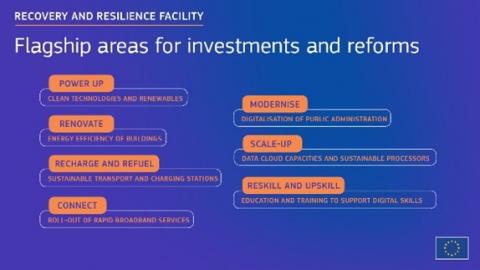Webinar recording: Green transition under the European Recovery and Resilience Facility

On 2 March 2021, the Policy Learning Platform hosted a webinar on the Green Transition under the European Recovery and Resilience Facility (ERRF).
As the spearhead of the ‘NextGenerationEU’, the ERRF will be composed of 672.5 billion EUR in loans and grants that will be used to trigger the recovery across all European regions and move past the current public health and economic crisis.
By April 2021, Member States will submit their National Recovery and Resilience Plans (NRRPs) to the European Commission, outlining which projects they intend to implement up to 2026 using resources coming from the Facility. At least 37% of the expenditure foreseen by NRRPs – amounting to 249 billion EUR – will need to go to investments and reforms to stimulate progress towards the achievement of climate and environmental objectives under the European green deal.
Against this backdrop, this webinar aimed to further shed light on the strong green dimension of the ERRF and look at the role of regions in the definition of green transition priorities under national recovery plans.
More than 260 participants attended this event to find out more information about the ERRF, learn about the green aspects of the recovery and discover how to access and use the Facility at local and regional levels. You can watch the recording below as well as access the presentations.
Webinar recording
Webinar agenda overview
Navigate to the discussion topics of interest in the webinar agenda overview below.
Moderation and concept by: Katharina Krell and Simon Hunkin, Thematic Experts of Low-carbon economy and Astrid Severin and Marco Citelli, Thematic Experts of Environment and resource efficiency.
00:3:11 Introduction to the Interreg Europe Policy Learning Platform services by Thorsten Kohlisch from Interreg Europe Policy Learning Platform.
00:17:10 Keynote speech by Adela Tesarova, from DG Energy provided insights into the Green Transition in the Recovery and Resilience Fund.
00:39:34 Q&A: Can you only submit to make use of grants and loans if you are a national body or also as a region or city? Could you tell us a bit more about the programming of the ERRF and how these funds filter down to the regional level?
00:44:05 Q&A: If a project is benefiting from the ERRF can it also benefit from other EU funds (ERDF, Horizon Europe, LIFE…)?
00:44:30 Q&A: How are depopulated and rural areas included in this plan?
00:45:55 Presentation by Simon Hunkin, from Interreg Europe Policy Learning Platform on regional and local authorities’ needs and expectations regarding the ERRF.
00:52:29 Presentation by Alessandro Drago, from the Lazio Region, Economic Programming Direction, provided insights on his region’s and Italy’s participation to the ERRF.
01:04:11 Presentation by Dr Irene Ruiz Bazán from the Provincial Government of Zaragoza, Spain on the MOMAr project and how to access the ERRF.
Panel discussion
01:13:10 Q&A: How about projects that are not mature? If there are no mature projects that cannot be allocated by 2023 and spent by 2026, what can a Region do? Isn’t it more important to wait to have the right project than to fund the wrong ones?
01:17:07 Q&A: What is the link between Interreg Europe and the ERRF? Is there anything else that could be said about this link?
01:20:53 Q&A: Can you give examples of good practices of synergies between the ERRF and the ERDF and?
01:23:21 Q&A: Which projects are you keeping for the ERRF and which ones for the ERDF?
01:25:01 Q&A: Where is it possible to find out more on how to combine the ERRF and the ERDF?
01:28:15 Q&A: What would you recommend to regional and local stakeholders and to our participants who have not yet begun to try to influence the plans and who are finding it hard to get involved in the public consultation process ? What are the first steps they should be taking?
Key learnings
The main take-aways that policymakers can draw from this webinar are:
- Green transition means turning gaps into opportunities. To access the ERRF policymakers are encouraged to draft NRRPs with a view to direct investments and reforms towards ‘flagship areas’ encompassing the sectors where the most jobs can be created, such as electricity from renewables, building renovations, zero emission mobility and the circular economy. Together with biodiversity and nature protection, these are also the sectors where increased investments are critical for meeting the enhanced 2030 climate targets and the 2050 net zero greenhouse gas emissions goal for the European economy.

Image source: European Commission
- European Green Deal as the backbone of the recovery. The ERRF will be the largest fund of the Multiannual Financial Framework (MFF) supporting green transformation. Consistency with European Green Deal policy objectives is thus required for NRRPs. These must also be aligned with European Semester country specific recommendations, National Energy and Climate Plans, Cohesion Policy and Just Transition programming.
- Green criteria and the ‘do no significant harm’ principle. The capacity to attract investments and facilitate reforms in relevant flagship areas will not be the sole criteria against which the green transition value of NRRPs will be measured. The Commission will also assess national recovery plans against 11 green criteria and guarantee the application of the ‘do no significant harm’ principle enshrined in the Sustainable Finance Taxonomy Regulation. This means NRRPs may not include fossil fuel projects.
- Climate tracking to define what is ‘green’. National governments will need to explain if and to what extent projects included in NRRPs contribute to the climate goal (at least 37% of climate-related expenditure). The methodology for tracking this will be consistent with the one used in the MFF to make sure that a part of the total EU budget (30%) is streamlined for climate action.
- Complementarity of the ERRF with EU Structural and Investment Funds. Projects may be supported both by the Facility and other funding instruments, such as the ERDF, provided that they are used on different expenditure lines. Given that ERRF resources will need to be disbursed by 2023 they should go to projects whose implementation can be rapidly ensured.
- Local and regional policymakers and the ERRF. National governments are responsible for internal coordination to prepare NRRPs. It is in their best interest to undertake public consultations and involve local and regional authorities: these are best placed to identify ‘ready-made’ projects that could immediately benefit from recovery financing.
- Priorities and expectations around the ERRF. Respondents to the survey conducted by the Policy Learning Platform prior to the webinar see clean technologies and renewables (68%), sustainable transport (59%) and energy efficient buildings (55%) as the most important flagship areas at local and regional levels. Most of them wish to access the ERRF to finance strategic planning (65%), capacity building (60%) and infrastructure development (56%). The degree in which they attempted to shape their respective NNRPs varies greatly: 45% took part into stakeholder meetings, sent proposals to competent ministries or coordinated bottom-up initiatives. 13% of respondents undertook no initiatives at all.
- Link ERRF support to regional sustainable development priorities. As the Lazio Region (Italy) has done, regions should intervene on the preparation of NNRPs by sending their proposals to the national level and making sure that a clear link between them and the fulfillment of goals set by Regional Sustainable Development Strategies is established.
- Create synergies to maximise impact. The experience of the Provincial Government of Zaragoza (Spain) shows that bottom-up approaches can be implemented to seize ERRF opportunities for the local level. The key is to gather stakeholders and define streamlined project proposals that can be brought to higher levels in the administration concerning the challenges that can be met with ERRF support such as, for instance, energy efficiency in heritage buildings.
- The value of Interreg Europe for the green transition under the ERRF. Both Lazio and Zaragoza praised Interreg Europe projects as a great source of inspiration when defining regional priorities to access the ERRF as well the catalyst role they play in bringing together local stakeholders that could jointly work on the design of project proposals for the recovery.
- The clock is ticking. The deadline for submitting Recovery & Resilience Plans is just around the corner. Hence, it is important not to miss out the last opportunity to influence the ERRF by using any available means. Ready-made projects and reform ideas for the green transition should be sent for integration into NRRPs with no further delay.
